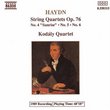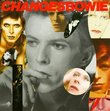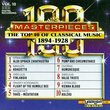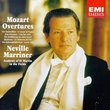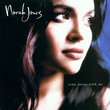| All Artists: Modest Mussorgsky, Jahni Mardjani, Maurice Ravel, Georgian Festival Orchestra, Nikolai Rimsky-Korsakov Title: Mussorgsky: Pictures at an Exhibition; Night on Bald Mountain Members Wishing: 0 Total Copies: 0 Label: Sony Release Date: 10/4/1994 Genre: Classical Styles: Opera & Classical Vocal, Forms & Genres, Theatrical, Incidental & Program Music, Historical Periods, Modern, 20th, & 21st Century, Symphonies Number of Discs: 1 SwapaCD Credits: 1 UPC: 074645723327 |
Search - Modest Mussorgsky, Jahni Mardjani, Maurice Ravel :: Mussorgsky: Pictures at an Exhibition; Night on Bald Mountain
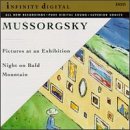 | Modest Mussorgsky, Jahni Mardjani, Maurice Ravel Mussorgsky: Pictures at an Exhibition; Night on Bald Mountain Genre: Classical
|
Larger Image |
CD DetailsSimilarly Requested CDs
|
CD ReviewsThe depth of friendship and the meaning of life. Melvin Pena | 07/08/2000 (5 out of 5 stars) "Initially I was attracted to Mussorgsky because a couple of the musical vignettes that comprise "Pictures at an Exhibition" were used as character or event themes in the cartoon series "The Smurfs", to wit, "The Gnome" and "Tuileries". Eventually going beyond the mere entertainment value of these, I read the history of "Pictures" provided in the accompanying booklet. Learning that the piece was composed by Mussorgsky as a tribute to his late friend Victor Hartmann, I listened to the recording all the way through, from a new perspective - How does the music convey Mussorgsky's feelings for his departed friend? The pace of this recording is slow - not lethargic, but pensive. Each vignette tells the musical story of Mussorgsky's reflections on the artwork of Hartmann, but more than that, the music is linked to the remembrance of his friend in each painting at the exhibition. Each "Promenade" section becomes increasingly quieter and more reflective, as the impact of Mussorgsky's loss becomes more apparent to him, and by extension, to the listener. For instance, the "Tuileries" is not simply a giddy piece about children, but about human youth and innocence. "The Marketplace at Limoges" speaks to the joys and fears of adulthood and maturity, leading into the somber and emotionally gripping vignettes that end the piece. Musing on the "Catacombs" and "With the Dead" the listener feels loss and anguish, but there remains at this point a sense of wonder at the friendship that inspired this work. "The Hut on Fowl's Legs" expresses frustration, even repressed anger with its mystical, unfathomable subject matter - Trumpets blare and horns wail and the surrounding violins ascending and descending scales sound like uncontrollable tears of joy and pain until they stop abruptly for the finale. "The Great Gate at Kiev" is the finale, in which the listener feels in the culmination of all the vignettes, the depth and pride of Mussorgsky's work. The grandeur of Ravel's orchestral rendering comes to complete fruition in this last vignette, where a solitary bell echoes out over the entire orchestra announcing to all the world the total worth of a friendship, and the importance of one man's life to another. To express this in words may be impossible, but Mussorgsky manages to achieve it musically, to spectacular and mind-shattering effect. The Georgian Festival Orchestra under Mardjani does amazing and beautiful work on this Sony Classics recording from 1994. "Night on Bald Mountain" and excerpts from "Khovanshchina" are also included on this disc, and are both well done themselves, but the "Pictures" suite is worth the price of the disc itself. This music has the power to restore faith in the goodness of humanity. Listen to it and experience it for yourself to-day." A wonderful score marred by listless playing and technical f Daniel White | Acworth, GA, USA | 03/25/2010 (1 out of 5 stars) "Pictures at an Exhibition. Modest Mussorgsky's masterpiece that was originally scored for piano has been transformed into countless versions interpreted for various ensembles: orchestral versions, brass ensemble versions, woodwind quintet versions, and even versions envisioning differently the original piano score. Just as Yesterday by The Beatles might be the most covered song ever written, Pictures at an Exhibition might be the most reinterpreted piano piece ever composed.
On this CD the most famous version and most oft played version of Pictures is performed, Ravel's orchestration. The French composer took Mussorgsky's original piano score and transcribed it to orchestra while subtracting the fifth, and final, Promenade in the process. The trumpet brings us in with a mysterious, shifting melody that gives a sense of walking through the exhibition. This "Promenade" is heard a couple of more times in various keys and arrangements throughout this work when the listener is "moving" from one painting to the next. The movements that aren't Promenades are composed to represent eleven different works of art by Viktor Hartmann, a close friend of Mussorgsky. These range from the dark, mischievous Gnome, to the playful Ballet of Children, to the grand Great Gates of Kiev. And every movement does a fantastic job of portraying the picture. And it pains me to say this because Pictures at an Exhibition is as close to perfection as Russian music gets, but this recording is completely listless in its execution. Whether it is the conductor or the players, this is one of the most boring recordings of Pictures, and to top it off, there are also a myriad of technical issues that the players have that mar the recording even more. The most obvious flaw listening to the recording straight through is it has one of the most abrasive trumpet sections. They not only get out of tune occasionally, but they also play so loud in some section (the ending of The Great Gates of Kiev in particular) that they completely throw off the balance of the orchestra. And when they are playing at such loud volumes, their timbre becomes so raucous that it is hard not to cringe a little. One last thing about the trumpets, the solo in Samuel Goldenberg and Schmuÿle is played so lackadaisically; there are missed notes and some very unpolished tonguing causing a murky, muddled sound. In whole, the entire orchestra really doesn't seem to gel together. The lower strings do an okay job throughout, and the upper strings are together most of the time. But the winds and brass seem to be working for a different conductor at times. Between rushing and not staying together as sections, it makes for some distracted listening. And that intonation problem mentioned earlier for the trumpets is orchestra wide. Winds going sharp, strings not hitting the right position, notes being accented oddly and not fitting the piece at all. It is all very amateurish. Now, I can overlook the occasional flubbed note or small intonation problem if the energy in the music is there. In this case, there is no energy to be had. The run time is similar to most other recordings of Pictures at an Exhibition, but the experience of listening to it feels so much longer. There is no enjoyment to be had, and I have listened to recordings with longer run times than this, but I was absorbed in the performance due to the energy being given out and the emotions be portrayed. I would almost call this a paint-by-numbers recording. In reality, this piece was just too hard for this orchestra to perform as there sounds to be parts cut (extremely fast double/triple tonguing trumpet sections most notably) and the hard parts are slowed to an incredible crawl. And even then, it still isn't together at that speed. And all the problems mentioned here for Pictures at an Exhibition carry over to Night on Bald Mountain and the two Khovanshchina pieces. It is a shame that such wonderful works are marred by technical deficiencies and what seems to be poor conducting. It just isn't worth recommending this recording even at its budget price. Note: Now, if you are on a budget, check out the Ukrainian National Symphony Orchestra's recording of Mussorgsky: Pictures at an Exhibition. It also includes both the original Mussorgsky version and Rimsky-Korsakov's version of Night on Bald Mountain, Sorochintsy Fair: Hopak, and an excerpt from Khovanshchina. And as a note, the UNSO version of Pictures is by far one of best, if not the best, recording of Ravel's Pictures. And it is also one of the few recordings of the original Mussorgsky version of Night on Bald Mountain. It is an infinitely better purchase than this. " |

 Track Listings (18) - Disc #1
Track Listings (18) - Disc #1